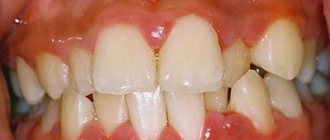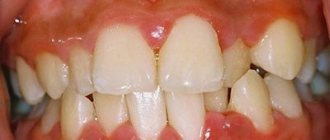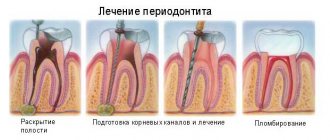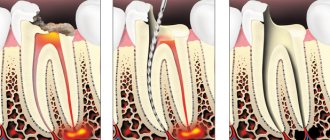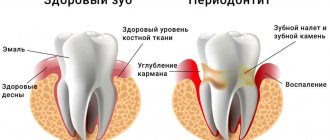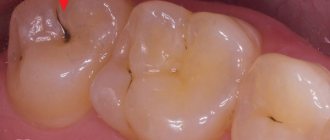There are a wide variety of dental diseases that damage the health of the teeth and oral cavity. Some pathologies - for example, primary caries - can be treated quickly and even without drilling the tooth; therapy for other diseases requires a whole course of procedures. For example, the treatment of periodontitis is always a complex process, since the disease affects not only the tooth itself, but also the tissues located next to it, which has a negative effect on the body as a whole.
If periodontitis develops to a certain stage, then all therapeutic measures may turn out to be useless and there will only be one way out - to remove the tooth. We will talk in detail about what periodontitis is, its forms, symptoms, and treatment methods in the following sections of the article.
Periodontitis: how does the disease appear and how does it develop?
Periodontitis is a term dentists use to refer to an inflammatory process that affects the tissues that surround the tooth and help keep it in the socket. The causes of periodontitis may vary in etiology (origin) and the disease is classified into subtypes. Correct diagnosis of the subtype of periodontitis is of fundamental importance: on its basis, the specialist will select the most effective treatment methods. Below we will get acquainted in detail with the forms of the disease, and also consider in detail their characteristic symptoms.
Infectious periodontitis
Dentists have to treat the infectious form of periodontitis in 90% of cases. The disease appears due to infection entering the root canals of the tooth and usually against the background of caries or pulpitis, the timely treatment of which was ignored. Infection in the canal cavities can also occur due to errors in endodontic treatment. The inflammatory process begins to actively develop from the moment pathogenic microflora enters the cavity of the dental canal. As inflammation spreads, not only soft but also hard tissues are destroyed; a granuloma can form, and if left untreated, a cyst.
IMPORTANT: The process of cyst formation can be asymptomatic, but the formation can grow to significant and dangerous sizes and lead to various types of pathologies, including deformation of the jaw joint.
Is it possible to treat periodontitis at home?
It is impossible to cure periodontitis at home on your own , since the cause of the disease is pathogenic microflora in the dental canals. The only way to remove them from the canals is to treat them with antiseptics and seal the canals, and this can only be done by a specialist. However, by waiting for a visit to the dental clinic, you can relieve symptoms of periodontitis and reduce pain before treatment. Antiseptic agents that do not irritate the mucous membranes can be used for oral baths 4-5 times a day. Doctors also recommend rinsing with a solution of salt and soda in order to relieve swelling and reduce the inflammatory process. Non-steroidal anti-inflammatory drugs are suitable for pain relief. These may help relieve symptoms, but are not treatments.
Author:
Retrograde periodontitis
This form of the disease is quite rare. Periodontitis of this form begins to develop against the background of infection penetration into the periodontium through the blood flow or lymph flow.
Traumatic periodontitis
Periodontitis of traumatic origin appears against the background of trauma, when a person receives a sufficiently severe bruise. Some medical errors made during dental treatment can lead to traumatic periodontitis:
- A small piece of an instrument that was “forgotten” after treatment in the cavity of the dental canals;
- Re-filling of the dental canal, which consists of excessive filling of filling material, which ultimately protrudes beyond the apical part of the tooth root;
- Incorrectly restored natural tooth crown, prosthesis, which constantly injure the tissues of the oral cavity.
Toxic periodontitis
This form of periodontitis usually occurs after poorly treated caries, and can occur due to tissue irritation caused by certain medications.
Each form of periodontitis has its own symptoms, but inflammation in the periodontium can also be determined by some general signs:
- Pulsating and clearly localized pain, the intensity of which gradually increases. The pain impulse intensifies at the slightest attempt to touch the teeth, during the period of their closure, while eating;
- The appearance of elevated body temperature due to toothache;
- Feeling of fullness in the area of the inflammatory process;
- Swelling of soft tissues.
IMPORTANT: Severe symptoms during the development of periodontitis are not present in all cases. Some phases of the disease can occur without the slightest external signs at all, or the person feels slight discomfort, which he mistakes for ordinary caries. Professional dental examinations, which are recommended to be carried out at least once every six months, will help to identify periodontitis in a timely manner for treatment.
Types of dental periodontitis
Treatment of periodontitis in Moscow depends on the form of the disease. The classification of pathological processes in periodontal tissues reflects the cause of inflammation, as well as the nature of its course. According to the etiopathogenetic principle, the disease is divided into 3 groups:
- Infectious periodontitis: caused by microorganisms living in the oral cavity. At the initial stages, microbes cause the development of caries. If the process is not stopped at this stage, the inflammation spreads to the pulp area of the tooth. The infection then enters the periapical tissues through the canal and the apical opening. Treatment of pulpitis in Moscow can be carried out at the North-Eastern Dental Center No. 1.
- Traumatic: occurs due to mechanical impact on the jaw (during a fall, blows, due to improper extraction of a nearby unit, etc.).
- Drug-induced periodontitis. It develops with an overdose or excessively long exposure to certain drugs used during endodontic treatment to necrotize the pulp. Medicines penetrate through the hole in the root apex into the soft tissues and destroy their fibers.
According to the nature of the course, acute and chronic periodontitis is distinguished. The first is accompanied by a pronounced clinical picture with intense pain, swelling of the gums, and other characteristic signs. According to the type of exudate, an acute process can be serous or purulent.
Chronic (sluggish) inflammation is characterized by an asymptomatic course. Depending on the histological changes occurring inside the ligamentous apparatus, fibrous, granulating, granulomatous chronic periodontitis is distinguished.
Treatment methods for periodontitis
The treatment method for periodontitis will be selected based on the characteristics of the clinical case. Methods that are used to treat inflammation in the periodontium can be divided into two groups - conservative and surgical. However, the goal of any treatment method for periodontitis will be to obtain the following results: elimination of all tissues that are affected by the infectious process, elimination of inflammation, restoration of healthy tissue, as well as restoration of the aesthetics and functional qualities of the dental unit.
To accurately diagnose, determine the form of periodontitis and select the optimal treatment method, a number of measures are carried out: a thorough examination of the patient’s oral cavity, radiography, CT, OPTG.
Vivid symptoms of periodontitis
The disease periodontitis cannot be confused with anything. It is accompanied by the following symptoms:
- the patient has severe periodic aching pain in the projection of the tooth;
- there is an increase in pain at the moment of biting;
- pain during periodontitis increases when the tooth is tapped with a hard object;
- the pain worsens at night and during the cold season;
- a purulent, inflamed sac around the gum, on which a fistula with purulent contents subsequently forms;
- mobility of the affected tooth is observed;
- Gaps appear between teeth;
- with periodontitis, bleeding gums are diagnosed;
- temperature rises;
- When sick, sleep is often disturbed;
- there is general weakness.
Very often, when a patient feels pain while biting food, he begins to chew on the other side, thereby freeing the pathological tooth from the load. During this time, the acute stage gradually turns into a chronic one, and the destructive process intensifies.
Therapeutic treatment of periodontitis: features and key stages
Therapeutic treatment of periodontitis is a complex, lengthy process and associated with certain difficulties. In particular, a fairly large amount of time is required to restore periodontal tissues damaged by inflammation; competent and high-quality treatment of dental canals will not be easy.
The complex of therapeutic measures for the treatment of periodontitis includes the following procedures:
- Drilling the diseased tooth to gain access to the canals;
- Work on expanding channels to a certain size, allowing for their high-quality processing;
- Painstaking cleaning of the canals from damaged and destroyed tissues;
- Flushing the canal cavity with antiseptic agents;
- Placement of antibiotic-impregnated linings into the tooth canals;
- Permanent canal filling;
- Restoration of the natural tooth crown.
Treatment of periodontitis may require repeated changes of medications in the canals, and therefore the patient is given a temporary filling for this period. After the inflammatory process can be completely eliminated, the tooth canals are filled with gutta-percha and a permanent photopolymer filling is placed on the tooth.
IMPORTANT: The more stages there are in the therapeutic treatment of periodontitis, the higher the price of the service as a whole will be.
When carrying out filling, it is extremely important to achieve complete sealing of the dental canals and all branches coming from them. After endodontic treatment of periodontitis, the doctor may additionally prescribe a number of medications for the patient to take that will help accelerate tissue recovery. Endodontic treatment of periodontitis can be supplemented by a number of physiotherapeutic procedures:
- UHF;
- Laser and magnetic therapy;
- Ozone therapy.
The need for additional physiotherapeutic procedures is determined by the dentist when drawing up a plan for the therapeutic treatment of periodontitis and based on the diagnostics performed and the characteristics of the clinical case.
Treatment of periodontitis and retreatment of tooth canals
Particular attention should be paid to the treatment of periodontitis with already obturated tooth canals, that is, teeth whose canals have previously been subjected to endodontic treatment. “Re-treatment” of such canals is an extremely labor-intensive and time-consuming process. The main difficulty is that clearing the canal of filling material is many times more difficult than carrying out the initial cleaning of odontogenic microflora and removal of the pulp (dental nerve) with subsequent sanitation.
When filling canals, the dentist is forced to focus not on the anatomy of the canal, but on the material with which it was filled during filling. This “blind work” requires the highest qualifications and extensive practical experience of the treating doctor. To remove obstructive materials from the root canal, for example, gutta-percha, in cases of retreatment, mechanical, chemical methods and their combination are used. The mechanical method involves working in the dental canals with instruments - files and profile files, and the chemical method - dissolving hard tissues with reagents. To date, a clear algorithm for repeated endodontic treatment when working with files and solvents has not been developed, depending on the manipulations in the apical, middle and mouth parts of the root canal 7. The next difficult stage after cleaning from filling materials in the treatment of periodontitis with previously obturated tooth canals is canal sanitation .
This stage plays a dominant role, since in order to significantly reduce the likelihood of a relapse of the inflammatory process, it is necessary to carefully carry out the treatment. In this regard, the dentist often places antiseptic medications into the canal for a while at this appointment. The crown part of the tooth is closed for this period with a temporary filling. After the time interval set by the doctor, further treatment is carried out - hermetically sealing the tooth canals and installing a permanent filling.
In cases where, while the integrity of the root is preserved, the coronal part of the tooth is severely damaged and subsequent prosthetics are required, after sanitation and before filling, an anchor or fiberglass pin is inserted into the canal. Then, after filling, an artificial stump is built up from composite materials, and only after this the process of creating and installing a dental restoration begins. In view of these difficulties, even the pinpoint accuracy and high qualification level of the doctor cannot guarantee 100% success in unfilling, subsequent sanitation and complete tightness during new obturation of such tooth canals. This is explained by the fact that small branches of the canal, especially the lateral deltas, may be inaccessible or difficult to navigate even with the most modern and ultra-thin endodontic instruments.
To achieve the best results in the treatment of previously obturated tooth canals, control targeted photographs are taken at each stage. This allows the dentist to avoid intensive instrumental and mechanical treatment and completely clean the canal from microbial contaminants, etc. Maintaining this balance is one of the main tasks of the doctor, since, without achieving balance at this stage, all this can lead to complications such as perforation of the tooth root wall, decreased mechanical resistance of the tooth, relapse of periapical inflammatory processes and, sooner or later, will lead to tooth loss. Therefore, the goal and main task of the dentist is to ensure the clinical and radiological success of endodontic treatment.
Effective treatment of dental periodontitis is an important and pressing problem of modern practical dentistry. The need to solve complex problems leads to the development and implementation in practice of clinicians of new approaches to mechanical treatment of root canals, new irrigation protocols, new technologies for filling canals, new principles of post-endodontic dental restoration, and requires the creation of new instruments and devices, medications and filling materials. Today, the key to the success of endodontic treatment is three-dimensional cleaning and obturation of the entire root canal system with sealing of all branches of the apical delta canals, including the lumen of the dentinal tubules.
Operative (surgical) treatment of periodontitis
Surgical techniques for the treatment of periodontitis are used if conservative therapy turns out to be ineffective or initially inapplicable due to clinical reasons. In 90% of cases, doctors try to perform tooth-preserving operations, that is, resort to a type of intervention that will eliminate inflammation, but at the same time preserve the dental unit. These types of interventions in the treatment of periodontitis include:
- Resection of the root apex. It is indicated for use when cysts and granulomas are identified during diagnostic procedures. The essence of the operation is to remove all infected tissues along with the apical part of the tooth root;
- Cystectomy. During this type of intervention in the treatment of periodontitis, the formed cyst or granuloma is removed, and the apical part of the root is excised, in which inflammation has caused pathological tissue changes.
After the operations, treatment and hermetically sealed dental canals are also carried out.
Another surgical method for treating periodontitis is an operation to amputate the apex of the tooth root. But it is possible only on multi-rooted teeth and taking into account the healthy state of the other roots of the dental unit. During intervention for the treatment of periodontitis, the crown part of the tooth can be preserved completely or partially removed. In our dental clinic in St. Petersburg you can receive services for safe and painless treatment of periodontitis. At all stages of the treatment process, dental specialists will use ultra-modern dental techniques and instruments to ensure the effectiveness of the treatment as a whole and guarantee the absence of complications.
Indications and contraindications for conservative treatment of periodontitis
There are two main routes that can be followed when treating periodontitis: conservative or surgical. Each direction has its own specific indications and contraindications.
In the modern world of dentistry, based on medical standards, the doctor should preferably use a conservative method for treatment. It is worth noting that the possibility of using a conservative method is determined by the condition of the affected tooth and the patient’s body. Indications for conservative treatment of periodontitis include both acute and chronic periodontitis, the appearance of cysts and granulomas, and tooth mobility.
But in some cases, surgical intervention should be used. The following are considered indications:
- obstruction of the root canals (impossibility of expanding them with modern endodontic instruments);
- the presence of a stump tab or pin that cannot be removed without damaging the roots;
- the presence of a deep bone pocket communicating with the periapical region;
- multiple perihilar cysts or those cysts that have grown into the maxillary sinus;
- perforation in the tooth cavity or root wall;
- large size of the periapical lesion (over 1 cm);
- ineffective conservative treatment methods;
- frequent exacerbations of the process (more than 1 time per month).
Features of the treatment of periodontitis in teeth with previously treated canals
Retreatment of tooth canals with periodontitis is an extremely difficult undertaking, during which the dentist will have to thoroughly clean the cavities from filling material. Only a truly competent and experienced specialist can perform such work in the treatment of periodontitis, because in the course of it it will be necessary to use different methods of cleaning the canals (using specialized reagents and files) and act in fact “blindly”.
After the tooth canals are completely freed from gutta-percha, they need to be thoroughly sanitized. At this stage of treatment of periodontitis, the care and literacy of the dentist are also important, because sanitary treatment of the canal cavities should ensure the complete exclusion of recurrence of inflammation in the future.
Typically, the canals for periodontitis are washed with a specialized solution, after which the doctor places medicine in their cavities and closes the tooth with a temporary filling. In the treatment of periodontitis, a pause is made, which is necessary for the complete cessation of the inflammatory process and the beginning of regeneration of tooth tissue. As soon as the desired effect in the treatment of periodontitis is achieved, secondary permanent filling of the canals and restoration of the tooth crown with a photopolymer filling are performed.
Stages of treatment of chronic periodontitis
How many visits to the dentist’s office will be needed for complex treatment of periodontitis will depend on the stage of inflammation (acute periodontitis, chronic, chronic in the acute stage), as well as the chosen treatment tactics. Periodontitis is often treated in several stages and requires about two or three visits to a dentist; installation of a permanent restoration is not advisable until the inflammatory process is eliminated.
- Preparatory stage : diagnosis using a panoramic photograph of the teeth, a targeted X-ray of the tooth, as well as control using CT; carrying out anesthesia.
- Opening the carious cavity or removing the previous filling material to access the pulp chamber, removing the nerve bundle.
- Expansion of root canal orifices.
- Treatment of canals with antiseptic solutions, application of medications, physiotherapy.
- Installation of a filling using temporary filling material.
- Removal of temporary filling material , treatment of the canals with antiseptic solutions (this stage is repeated until the inflammatory process subsides; several months of treatment may be required).
- Control x-ray and placement of a permanent filling.
During visits for periodontitis, antibacterial, anti-inflammatory drugs and rinsing with disinfecting solutions are prescribed for treatment at home.
Diagnostics and treatment of tooth canals
The first place in the treatment of periodontitis is a thorough examination of the patient’s health status, after which the specialist prescribes x-rays. In our clinic, for the convenience of patients, we have CT technology, the ability to take panoramic images of all teeth, as well as targeted radiography of a specific tooth. Thanks to the X-ray image, the diagnosis is made with maximum accuracy. It is also possible to study in detail the number of canals in the roots of teeth, their length and shape. Next, an injection with anesthesia is made into the area of the causative tooth, without which treatment of periodontitis can cause pain and discomfort.
After pain relief occurs, the doctor will perform the following manipulations:
- Removal of all carious tissue from the causative tooth, as well as part of the adjacent unaffected enamel and dentin for better access to the mouths of the root canals;
- In a previously untreated tooth, the doctor will remove the inflamed pulp. In a previously endodontically treated tooth, the tooth canals are unfilled;
- Expansion of the tooth canals using manual and mechanical endodontic instruments, followed by rinsing with an antibacterial solution;
- Placement of medication with enhanced antiseptic effect into the channels;
- Afterwards, a temporary filling is placed;
- The patient is consulted on oral care at home, anti-inflammatory drugs and antiallergic medications are prescribed;
- The next visit to the doctor will take place after completion of the first stage of periodontitis treatment - three days later.
Temporary filling of tooth canals
When you return to a dentist-therapist during the course of treatment for chronic periodontitis, the area for further manipulation is examined. The specialist must clarify whether the patient has complaints of pain, swelling in the gum area of the causative tooth or other discomfort. In the absence of these negative phenomena, temporary filling of the root canals of the tooth is performed.
To do this, first of all, the temporary filling and the antiseptic drug placed in the tooth canals are removed. The canal mouths are carefully treated with an antiseptic and then filled with a special medicinal material that contains calcium hydroxide, a substance that kills pathogenic microorganisms and stimulates the regeneration processes of bone tissue in the area of the apex of the tooth root. Temporary filling of root canals is carried out for a long period - from a month to three. At the end of the visit, the dentist closes the tooth cavity with a temporary filling.
Permanent filling of tooth root canals
During the third visit to the dentist during root canal treatment, a permanent filling is performed. First, the specialist sends the patient for a control x-ray, which determines the effectiveness of periodontitis treatment. If there is a decrease in destroyed bone tissue, permanent canal filling is performed.
The procedure begins with the removal of a temporary filling from the crown of the tooth, then the canals are freed from the previously laid healing material. The doctor rinses the root canals with an antiseptic and then fills them to the root apex with a composite. At the end of the work, the patient is given a final x-ray to control the quality of the filling performed. Gutta-percha pins must be tightly compacted in the canal to the very apex of the root, otherwise there is a high risk of relapse of the disease.
You may have toothache after periodontitis treatment. Normally, they last 3-5 days and gradually fade away. If the pain does not subside or returns with renewed vigor, retreatment is necessary.
The patient should come to the doctor for installation of a permanent restoration of the crown of the tooth at the next, fourth visit. The filling material in the root canals becomes denser, and the discomfort after intervention in the canals disappears.
Traditional medicine: can its recipes help with periodontitis?
It is important to understand that periodontitis is a serious disease that affects the entire body as a whole and is fraught with serious complications. Its treatment cannot be carried out at home, since the infectious process occurs deep in the root canals of the tooth and it is important to thoroughly clean them of all tissues affected by inflammation. Only a doctor can do this - in a clinical setting and using a specialized instrument.
Remedies from folk recipes will be absolutely useless in the fight against periodontitis and, moreover, they can aggravate your condition. For example, hot compresses for periodontitis can provoke an acceleration in the rate of spread of inflammation.
Herbal decoctions and tinctures are powerless against periodontitis. They can only temporarily make the pain less pronounced, but in this case the inflammation will actively develop, affecting an increasingly larger area of tissue. If you are bothered by even a minor toothache, a reasonable solution would be to immediately consult a dentist. Remember that it is not always possible to save a tooth with periodontitis (especially with an advanced stage of inflammation).
Reasons for the development of periodontitis.
When caries begins, pathogenic bacteria begin to actively multiply and if the disease is not cured in a timely manner, the inflammatory process spreads to the enamel and affects the dentin. When the infection reaches the pulp, a complication of caries develops. It is untreated pulpitis that causes periodontitis. Once in the periodontium, the infection begins to irritate it, causing its response. This is how our body reacts to problems: the patient may experience increasing pain, which is localized and sometimes becomes completely unbearable.
It should also be noted that the formation of periodontitis is also possible under other conditions:
Poorly sealed canals.
When filling, it is important to fill the root canals tightly and correctly with the material, and for this it is necessary to determine their size using radiography. If the dentist skipped this stage and did not fill the canal, inflammation may begin in the remaining space.
Mechanical injury to the jaw or teeth.
Very often, periodontitis occurs in children, because... Little fidgets constantly fall, and sometimes they can hurt their faces, you should pay attention if your child, after such an active walk, begins to complain of severe tooth pain.
Development of infection under the crown.
In this case, periodontitis occurs due to the incompetence of the doctor, or he incorrectly carried out the preparation stage and poorly processed the tooth and filled it, or an error was made when placing the crown, and the dentist did not remove the dead pulp.
Use of arsenic.
Previously, arsenic was used to kill the pulp, if the dose is incorrectly determined and with its long-term effect on the body, there is a high risk of an inflammatory process in the periodontal area. Currently, dentists use high-quality anesthetics that allow them to treat and remove the pulp without exposure to arsenic paste.
Use of antiseptic drugs.
One of the main reasons for the development of drug-induced periodontitis is the excess concentration of drugs during filling and treatment of root canals.
Periodontitis treatment time
If you have been diagnosed with periodontitis, you should prepare for a lengthy treatment process. You will have to visit the dental clinic more than once, and in addition, strictly follow all the recommendations that the specialist will give you during the treatment process. Violation of medical recommendations can lead to complications that will increase the complexity and duration of periodontitis treatment. In the simplest case, when treating periodontitis, you will have to visit the dentist two or three times; treatment will be longer if it is supplemented by physical procedures and will require repeated placement of antibiotics into the tooth canals and consultation with highly specialized specialists. Remember that high-quality treatment of periodontitis will imply mandatory control photographs after each stage.
Radiography will allow you to track the positive changes achieved after certain procedures for the treatment of periodontitis, and evaluate the quality of canal filling. Only this approach guarantees a stable and positive result in the treatment of periodontitis and eliminates relapses of inflammation and complications.
Emergency dental care in the treatment of periodontitis
While emergency care is provided to the patient during the treatment of periodontitis, it is primarily necessary to open the causative tooth in order to create an outflow of purulent exudate that has accumulated at the apex of the root. If acute periodontitis is accompanied by swelling of the gums, before treatment, an incision is made opposite the apex of the tooth root.
With an open tooth cavity, without a filling, the patient needs to walk around for several days, after which a second visit to the dentist will take place. For the entire period without a filling, when eating and drinking, it is necessary to close the cavity with a cotton swab, and then remove it - this will prevent pieces of food from entering the mouth of the canals, and will also avoid a possible relapse of inflammation.
The stage of providing emergency care as part of the treatment of acute periodontitis is a loyal service at a price. Its approximate cost is in the range from 2000 to 3000 rubles. But you should know that this is not the end of the treatment and it must be continued.
After the tooth cavity is opened during the treatment of acute apical periodontitis, the patient is prescribed a course of antibiotics and oral baths, as well as antihistamines.
Periodontitis treatment price
The cost of periodontitis treatment is always calculated individually, because it consists of a number of factors. The price of the service will depend on the set of diagnostic measures that are carried out not only at the beginning of treatment, but also at its intermediate stages. The price of the service will be influenced by the form of the disease, method of treatment, additional procedures, equipment and drugs that can be used during its course.
If you want to know the price of periodontitis treatment or make an appointment with Uni Dent dentists, just dial our contact phone number!


